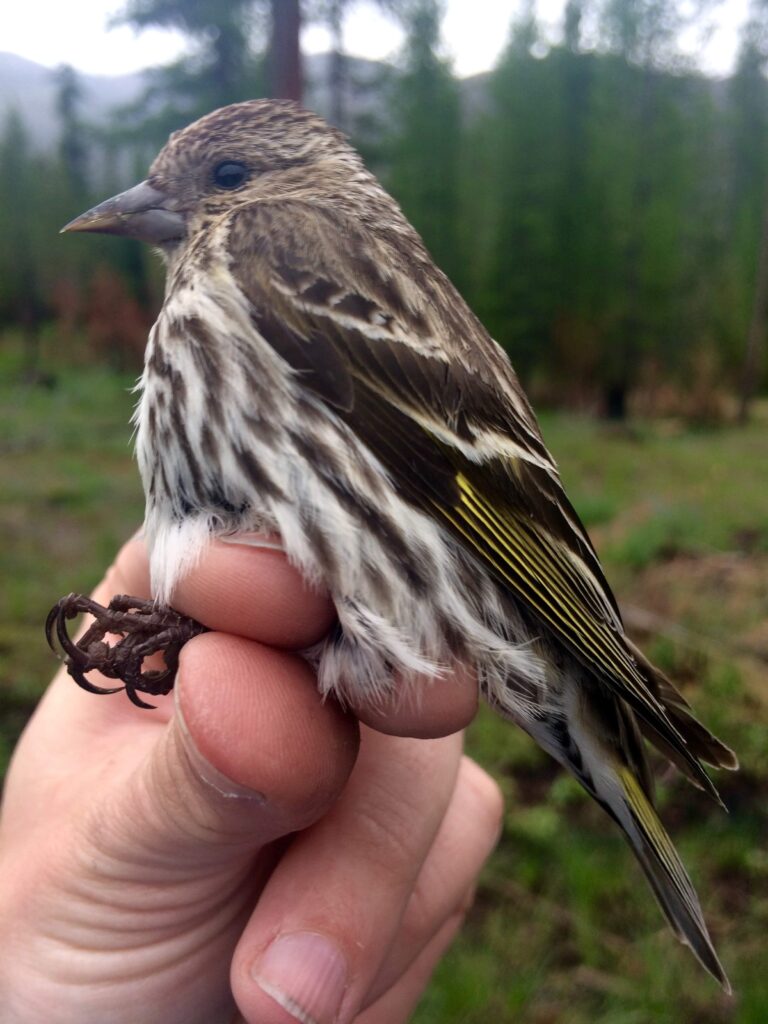On the Move


Pine Siskin caught by Joely DeSimone
Pine Siskins, commonly found in Montana’s open-canopied evergreen and mixed evergreen-deciduous forests, move from place to place in search of abundant conifer seeds. These seeds are produced in cone crops that vary in abundance across time and space; in a single year, a cone crop in one area might be limited—or fail entirely—while in another area the cone crop can be prodigious. Distances between successful crops vary widely, which means that sometimes these birds must leave areas where feeding conditions are poor, and migrate thousands of kilometers to find more abundant food sources.
Animals that migrate at unpredictable times to unpredictable places, often in direct response to resource availability, are called facultative migrants. Unlike obligate migrants, which are genetically hardwired to move in response to changes in daylength, facultative migrants can stay in one place for as long as their required resources hold out. But how does this strategy work? Do facultative migrants respond to dwindling food supplies by preparing for an impending journey? Or do they simply escape when food supplies are sufficiently low? These are some of the questions that prompted recent University of Montana graduate Dr. Joely DeSimone and her colleagues to study facultative migration in western Montana’s Pine Siskins. The results of their study were recently published in the journal Functional Ecology.
The study was based on two hypotheses: the Prepare Hypothesis predicted that, in response to declining food availability, Pine Siskins would undergo physiological changes such as are experienced by obligate migrants (for example an increase in body fat content), which would help prepare them for migration. The Escape Hypothesis predicted that Pine Siskins would not prepare for departure ahead of time, but rather would experience body condition declines in response to food availability declines, with departure prompted by a stress response. DeSimone and her team measured three different indicators of physiological condition, plasma triglycerides (which indicate increasing fat stores), the hormone corticosterone (or CORT, which is associated with both preparation for obligate migration and animals’ stress responses) and physical activity levels (in captivity, birds that are ready to migrate move around a lot). The research team had found in an earlier study that in the laboratory, under experimental conditions, Pine Siskins with reduced food availability lost fat mass, increased CORT levels, and showed increased physical activity, all things that are generally indicative of an “escape” response. But after seeing how birds behaved in the lab, the team wanted to know what Pine Siskins do in the wild.

Aerial Photo of the Bitterroot Valley adjacent to MPG by Joely DeSimone
DeSimone and her team focused their research efforts on MPG Ranch, in Florence, MT. They captured birds using mist-nets, collected morphometric and physiological data, then fitted the birds with radio tags and released them back into the wild. Using signals from both handheld telemetry receivers at MPG Ranch and fixed Motus telemetry stations located across North America, the team was able to remotely detect the location and movement of each bird without causing further disturbance. Birds tagged during this study were later detected as far away as Ontario, Canada!
What the team discovered was somewhat surprising. Unlike animals studied in the laboratory, which demonstrated an escape response, wild Pine Siskins showed a response pattern that was intermediate between preparation and escape. Birds with poorer body condition remained at the field site longer than those in better condition. But among birds with higher body condition, departure time varied. Once an apparent threshold in body condition was reached, it appeared that other factors (possibly weather or social information) came into play regarding the decision of when to depart. DeSimone and her colleagues concluded that different food availability scenarios result in different responses. Where food is critically low, birds must leave, or face starvation. Where food is only moderately low, birds are less likely to depart: they can still manage to subsist on local food resources but they can’t store sufficient fuel for a departure flight. Where food availability is relatively higher, presumably more fuel can be stored, the risk associated with movement is decreased and so the probability of departure increases. While the birds studied in captivity responded as per the low food-availability scenario, birds in the field appeared to fit the intermediate range of the model. Above a threshold body mass, timing of departure varied. These Pine Siskins likely had enough fuel to depart, but it appeared that the timing of their departure may have been determined by cues other than body mass.
Because facultative migrations are unpredictable by nature, they have been historically challenging to study in the wild. This study was possible because of advances in technology that allowed researchers to track bird movements without having to later resight or recapture them. When we caught up with DeSimone in January of 2023, she said she was looking forward to future iterations of transmitters that would be able to trace the movements of facultatively migrating songbirds across seasons and years, without the current limit of a 3-month battery lifespan.
In addition to shedding light on the physiological processes associated with migration, this work also highlights the value of testing hypotheses in both the lab and the field. In the lab, where isolated variables can be held constant or manipulated experimentally, one can investigate specific mechanisms of animal behavior. Though important, the findings of these lab studies don’t always translate perfectly to behavior in the wild, where there are more variables at play and food availability and animal movement operate at a much larger scale.
To learn more about Dr. DeSimone’s research, check out her website!
